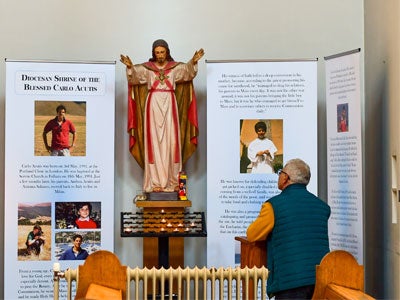Canonizing a millennial saint: CWRU experts weigh in on what Carlo Acutis means for today’s church

Yesterday (Sept. 7) at the Vatican, Pope Leo XIV officially canonized Carlo Acutis, a 15-year-old computer enthusiast from Italy who died in 2006 and has since become known as the “patron saint of the internet.”
To learn more about the significance of Acutis’s canonization, we spoke with Brian J. Clites, the Archbishop Hallinan Professor of Catholic Studies II, and Jonathan Tan, the Archbishop Paul J. Hallinan Professor in Catholic Studies I at Case Western Reserve University. Clites and Tan, whose research examines Catholicism, offered insights into what Acutis’s life and sainthood reveal about the Catholic Church’s relationship with younger generations in the digital age.
Read on to glean their insights.
1. How does the church typically select saints, and what might be different about canonizing someone from the millennial generation?
Clites: The path to sainthood involves a long process, so most saints aren’t canonized until decades after their death.
Here’s a laymen’s outline of the process:
- Step 0: When a beloved Catholic dies, their followers can informally begin the process of cataloguing the person’s holy acts. Followers will also try to keep the memory of that person vibrant and in the news, because the formal church process cannot start until a minimum of five years after the person’s death.
- Step 1: After five years, if there is still significant devotion to the person, then followers can work with a priest or bishop to write an official “petition” for canonization. If the Vatican accepts the petition, then the Pope appoints a bishop to collect evidence of the person’s sanctity, including any miraculous events in their life.
- Step 2: All of that evidence is compiled into a report, which is sent to the appropriate Vatican office (The Congregation for the Causes of Saints.) They vote on the file, and if it passes then the process continues onto the next stage, called “Beatification.”
- Step 3: “Beatification” elevates the person’s stature to “Blessed,” which requires formal verification of the person’s holiness. Martyrdom is one route (Catholics who died in defense of their faith); miraculous works are the other route. In Carlo’s case, the Vatican office investigated and verified Acutis's miraculous healing of a young boy in Brazil who followed Carlo on the internet. Again, the evidence is voted on by several Cardinals in the Vatican, who then make a recommendation to the Pope, who can then choose to Beatify the person. Carlo was beatified in October 2020 by Pope Francis.
- Step 4: A second miracle. After the beatification, another miracle needs to occur and be verified by the Vatican. In Acutis’s case, a young woman suffered a head trauma while biking, and she faced a perilous recovery. Her Italian doctors did not have high hopes, but her mother prayed to Acutis and she made a miraculous recovery. The folks at the Vatican voted to count this (or, in formal speak, “to attribute the miracle to the intercession of the Blessed, Carlo Acutis.”).
Finally, the new saint must be formally canonized, usually at a mass led by the Pope at the Vatican. That’s what happened Sunday—Pope Leo made it official.
2. What aspects of this millennial saint’s life resonate most with younger people today?

Clites: Many of the “old” saints are known for stuff that probably seems weird to most young people today. For example, St. Lucy (who is often depicted holding a platter with her own eyeballs on it), was a fourth century Italian virgin who refused an arranged marriage. Incensed, her betrothed sentenced Lucy to be raped at a brothel. But Lucy’s chastity and faith were stopped so strongly that she gouged out her own eyes to preserve her virginity. (An aside: There are actually several accounts of how and why Lucy became a Saint, but this is the one that was most celebrated among twentieth-century Italian American Catholics, whose patriarchal families placed tremendous emphasis on Catholic girls’ purity.)
By contrast, Carlo did things that many young people today find normal and endearing. For example, he loved video games. His most prized possession was his Sony Playstation. Acutis talked about limiting screentime as an act of faith. (He attempted to limit his Playstation use to one hour per day, as a devotional sacrifice.)
Acutis was also a computer geek. He loved the internet—remember, he died almost twenty years ago, so the internet was a lot less intuitive to navigate. He found all kinds of quirky websites about Eucharistic miracles, and so he started his own site to create a kind of online encyclopedia of these miracles, thus inspiring lots of other young dorky Catholics to learn about them.
In other words, Acutis was a “normal”(ish) kid who spent a lot of time online. But, contrary to the bad rep that habit often gets in the news, he was—like many students still do today—actually using the internet to do good.
3. In what ways does this canonization reflect broader trends in religion and spirituality among millennials and Gen Z?

Clites: This is our first digital saint. His life was spent on screens. He became famous through his online persona, even more so after his death. A lot of older Catholics poo-poo the digital age, but here’s a devout, wholesome kid who has inspired millions of other young Catholics through his life online.
Tan: For much of the Catholic Church's history, saint-making focused on holy women and men who were either prominent popes or bishops, founders or leaders of important movements and religious organizations, reformers, martyrs who died in defense of the church's teachings, or whose exemplary life within the church or religious community were held out as examples for others to emulate. What makes Carlo Acutis unique is a contemporary young church who is very much involved in the contemporary world—not just physical but also in the online virtual world where young people also congregate today.
Unlike traditional saints, Carlo is also someone whom many young people can identify with—a geek or nerd at ease online as well as in church, in touch with his deep spirituality and strong faith, while also immersed with a digital presence like many of his contemporaries. Acutis reflects the sort of Catholic whom the late Pope Francis wished to highlight and hold up for others to emulate. Setting him on the path to sainthood with his beatification is the first step in this process.
4. How do contemporary social issues—mental health, social justice, climate change—factor into the lives or appeal of modern saints?
Clites: I think there’s a real disconnect between the moral issues that animated Catholics in the 1980s-2000s and the issues that are most important to young Catholics today. Debates about birth control, abortion, and sex have become antiquated (and stuck in a seemingly endless loop of politicization). Whereas many young Catholics today are most concerned about the issues identified here—foremost climate change, but also issues such as immigration, racial justice, and well-being.
5. Are modern saints more “relatable” than historical saints? If so, how?
Clites: Yes, I certainly think so! Compare Mother Theresa to St. Lucy (mentioned above). Theresa devoted her life to helping the poor and the sick. Although that’s still kind of old-fashioned, I think a lot of young people can still relate to that form of selfless sacrifice (as opposed to Lucy’s self-martyrdom).
6. How does media coverage and social media influence public perception of saints today?
Clites: Carlo is one of the first saints who has had such a wide appeal on social media. It’s clear that his enormous online following put pressure on the Vatican to move swiftly toward his canonization. Which is to say: as a collective, Catholics on social media have tremendous power. They CAN (in fact) influence the way that cardinals and even the Pope think about the contemporary world.
7. What might this canonization suggest about the future direction of the church in engaging younger generations?
Clites: Some scholars would even go so far as to say that canonization is really about public relations. At any rate, I think Acutis’s rapid path to sainthood speaks to the Vatican’s desire to connect more authentically with younger Catholics. The church has had so much bad publicity over the past several decades (some deservedly, as in the case of clergy sexual abuse, which is what most of my own research focuses on). Saint Carlo is an easy “win” for the church—a way to show its younger members that the faith isn’t as outdated and out of touch as it sometimes might seem.




